Aloe pruinosa
Aloe pruinosa Reynolds
Family: Asphodelaceae
Common names: powdery aloe, Bisley Valley aloe (Eng.), kleinaalwyn, slangkopaalwyn (Afr.), icena, icena elikhulu (isiZulu)
Introduction
Aloe pruinosa, commonly known as the powdery aloe, is a striking and lesser-known succulent, endemic to the midlands of KwaZulu-Natal, that has both botanical charm and ecological importance, and is one of the few aloes that prefers shade.
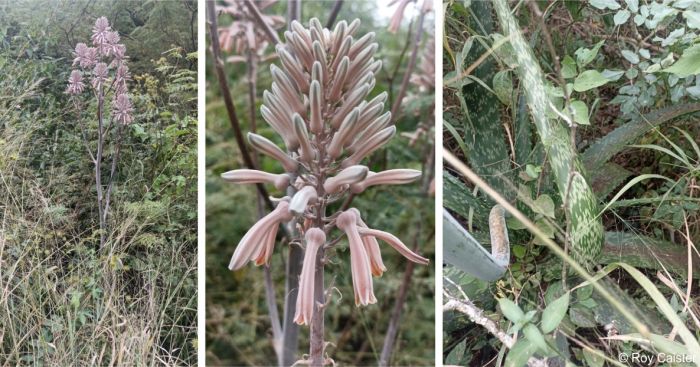
Description
Description
Aloe pruinosa is a solitary succulent with a short stem 300-500 mm long that often lies flat on the ground or is partially buried. It forms a rosette, 250-600 mm tall, of thick, fleshy leaves up to 700 mm long and 100 mm wide that are bright green and mottled with pale whitish H-shaped spots irregularly arranged in transverse bands. The lower surface is a brighter shade of green with more spots in more distinct bands. The margin is lined with small, pinkish-brown prickles. The plant produces an inflorescence 1.4-2 m tall, with 11-20 branches, bearing conical racemes of tubular, darkish pink to brownish-red flowers, 24-33 mm long. Both the flowers and the flower stalk are densely covered with a greyish-white powdery bloom. Flowering typically occurs in late summer (February to March). A plant may produce 1 to 3 inflorescences in a season.
Aloe pruinosa may be confused with Aloe greenii, which is a smaller plant with rosettes only 120-250 mm tall, it lacks the waxy bloom on the flowers and it readily suckers from the base forming large groups where Aloe pruinosa remains solitary.
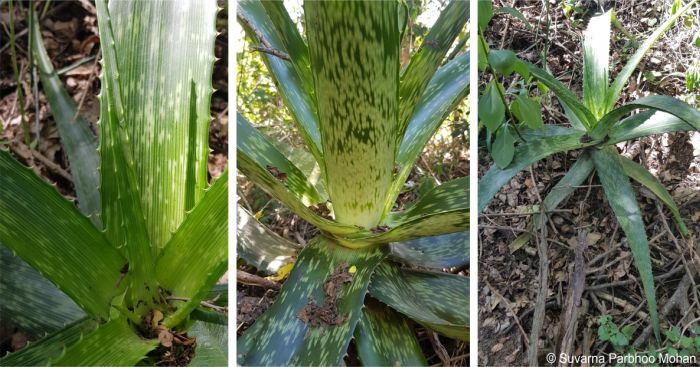
Conservation Status
Status
Aloe pruinosa is a rare species and is currently listed as Vulnerable (VU) according to the South African National Biodiversity Institute (SANBI) Red List of South African Plants, meaning that it is endangered and faces a high risk of extinction. Like many endemic plants in South Africa, it faces risks from habitat loss and degradation, overgrazing, and illegal collection. Aloe pruinosa is known from 7 to 10 locations over a small area and its population is declining due to habitat loss and harvesting of whole plants for the traditional medicine trade, and ongoing monitoring is necessary to ensure its survival. The powdery aloe occurs in the Bisley Valley Nature Reserve south of Pietermaritzburg, but urban expansion and industrial development are rapidly encroaching, even on this protected locality, which puts its continued survival at risk. This species is threatened by commercial sugarcane plantations, the conversion of natural lands to pasture and other crops, and forestry plantations between Albert Falls and Wartburg. Whole plants are harvested and sold at traditional medicine markets in the Maphumulo area.
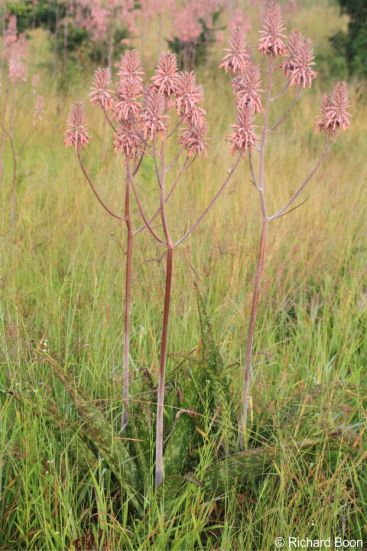
Distribution and habitat
Distribution description
Aloe pruinosa is endemic to the KwaZulu-Natal midlands in South Africa, from south of Pietermaritzburg to Maphumulo, where it grows in small and scattered populations, in shaded places in bushveld and thornveld. It thrives in well-drained loam soils among small and medium sized trees, grasses and herbaceous plants and is adapted to areas with fairly high summer rainfall and occasional drought, reflecting its resilience to variable climatic conditions.
Derivation of name and historical aspects
History
The genus name Aloe comes from the Arabic word alloeh, meaning shining bitter substance, referring to the sap of many Aloe species, which has long been used for medicinal purposes. The species name pruinosa is derived from Latin, and means frosted or covered with powder, a reference to the whitish bloom on the flowers and flower stalks. The genus Aloe is part of the Asphodelaceae family and includes over 500 species of flowering succulents found primarily in Africa, the Arabian Peninsula and Madagascar.
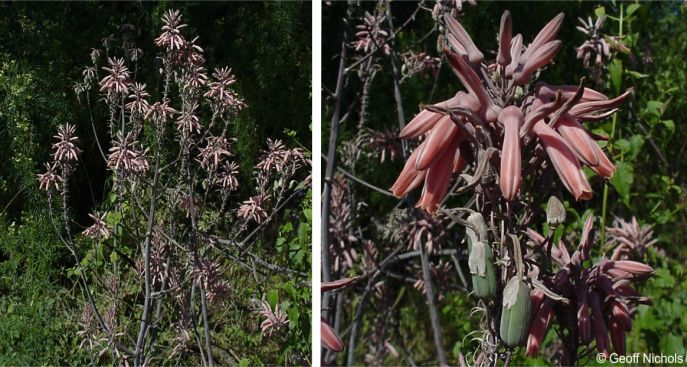
Ecology
Ecology
Aloe pruinosa plays a vital role in its native ecosystem. Its tubular flowers attract pollinators such as sunbirds, bees and other insects, which feed on the nectar and pollen. Like other aloes, it is well-adapted to fire-prone habitats; while the above-ground parts may be scorched, its succulent nature resists burning and the root system allows the plant to regenerate. It also helps prevent soil erosion on rocky hillsides due to its fibrous root system.
Uses
Use
While not as widely known or used as Aloe ferox or Aloe vera, Aloe pruinosa has traditional medicinal and horticultural value within local communities. Its ornamental appeal and drought tolerance make it a desirable plant for rock gardens and succulent landscapes. However, it is not commonly seen in commercial cultivation. Its use in traditional medicine appears to be limited to KwaZulu-Natal and it is not sold on a large scale. Aloe pruinosa holds significant cultural value within the traditional medicine systems of the Zulu people of South Africa where it is used as a protective charm against lightning and evil, and in traditional medicine as a birth facilitator and to treat skin itches.
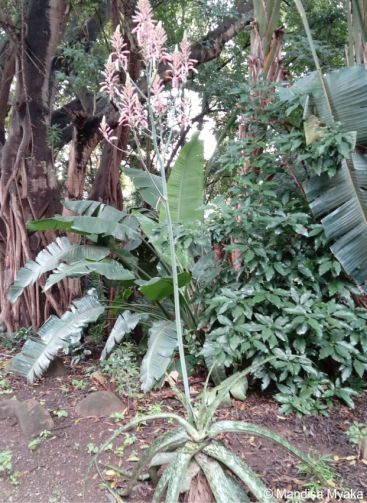
Growing Aloe pruinosa
Grow
Aloe pruinosa is relatively easy to grow under the right conditions. It prefers partial shade, dappled shade or light shade and well-drained, loam soil. Good drainage is essential to prevent root rot. Grow it under trees like thorn trees (Vachellia and Senegalia) that cast light shade, or in semi-shaded beds that get sun for part of the day. Feed with organic fertilizer, such as well-rotted compost, in spring and summer. With minimal care and attention to watering, Aloe pruinosa can thrive and add structural beauty to any drought-tolerant garden or succulent collection. Plants are also suitable for containers. Place it in bright, indirect light, and water only when the soil is dry. It can withstand short periods of drought and needs less water in winter. Overwatering should be avoided, as this can lead to root rot. In colder regions, it should be grown in containers and protected from frost or moved inside during during winter.
Propagation of aloes is typically done through seeds or division of offsets (pups). Aloe pruinosa rarely produces small plants around its base, thus it is best propagated by seeds. Sow fresh seeds in spring or early summer.
References
- Caister, R. 2024-Mar. Observation of Aloe pruinosa, Umgungundlovu. iNaturalist. Online. https://www.inaturalist.org/observations/203235777.
- Crouch, N., Smith, G. & Myeza, N. 1997. Aloe pruinosa: a rare spotted-leaf aloe from the KwaZulu-Natal midlands. Plantlife 17:30-31.
- Glen, H.F. & Hardy, D.S. 2000. Aloaceae (First part): Aloe. In: G. Germishuizen (ed.), Flora of Southern Africa, Vol. 5, Part 1, Fasc. 1: 1–159. National Botanical Institute, Pretoria.
- Mtshali, H., Victor, J.E. & Scott-Shaw, C.R. 2020. Aloe pruinosa Reynolds. National Assessment: Red List of South African Plants version 2024.1. https://redlist.sanbi.org/species.php?species=2206-215.
- Myaka, M. 2025-Apr. Observation of Aloe pruinosa, Umgungundlovu cultivated. iNaturalist. Onlin.e https://www.inaturalist.org/observations/272403852.
- Parbhoo Mohan, S. 2021-Dec. Observation of Aloe pruinosa, Locality obscured. iNaturalist. Online. https://www.inaturalist.org/observations/103139887.
- Reynolds, G.W. 1969. The aloes of South Africa. Balkema, Cape Town.
- Richard Boon 2018 March Observation of Aloe pruinosa, Umgungundlovu. iNaturalist. Online. https://www.inaturalist.org/observations/215199347.
- Smith, G.F. & Crouch, N.R. 1995. Notes on Aloe pruinosa Reyn. (Aloaceae), a rare and little known maculate from the midlands of KwaZulu-Natal, South Africa. Aloe 32(3&4):66-69.
- Smith, G.F., Crouch, N. & Condy, G. 1999. Aloe pruinosa. Flowering Plants of Africa 56:2-6.
- Van Wyk, B. & Smith, G.F. 2014. Guide to the aloes of South Africa. Briza Publications, Pretoria.
- World of Succulents. Aloe pruinosa (Powder Aloe). https://worldofsucculents.com/aloe-pruinosa/. Accessed on 2025/10/08.
Credits
Philisiwe Biyela, Pretoria National Botanical Garden
and Alice Notten, Kirstenbosch National Botanical Garden
November 2025
Acknowledgements: images by Geoff Nichols, Mandisa Myaka, Richard Boon, Roy Caister and Suvarna Parbhoo Mohan.
Plant Attributes:
Plant Type: Succulent
SA Distribution: KwaZulu-Natal
Soil type: Sandy, Loam
Flowering season: Late Summer
PH: Acid, Neutral
Flower colour: Pink
Aspect: Full Sun, Morning Sun (Semi Shade), Afternoon Sun (Semi Shade)
Gardening skill: Easy
Special Features:
Horticultural zones








Rate this article
Article well written and informative
Rate this plant
Is this an interesting plant?
Login to add your Comment
Back to topNot registered yet? Click here to register.